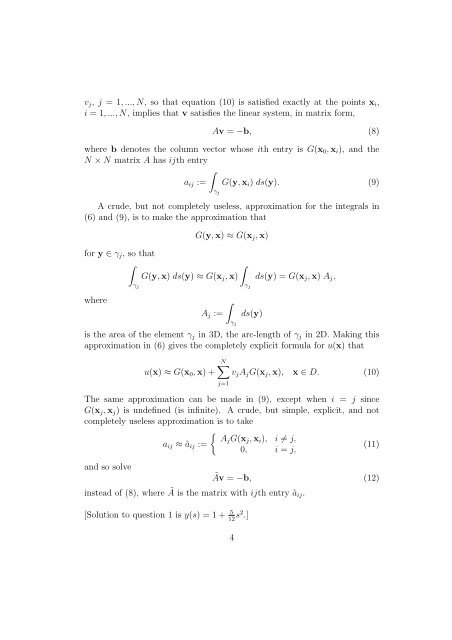Boundary element methods for acoustics
Boundary element methods for acoustics
Boundary element methods for acoustics
Create successful ePaper yourself
Turn your PDF publications into a flip-book with our unique Google optimized e-Paper software.
v j , j = 1, ..., N, so that equation (10) is satisfied exactly at the points x i ,<br />
i = 1, ..., N, implies that v satisfies the linear system, in matrix <strong>for</strong>m,<br />
Av = −b, (8)<br />
where b denotes the column vector whose ith entry is G(x 0 , x i ), and the<br />
N × N matrix A has ijth entry<br />
∫<br />
a ij := G(y, x i ) ds(y). (9)<br />
γ j<br />
A crude, but not completely useless, approximation <strong>for</strong> the integrals in<br />
(6) and (9), is to make the approximation that<br />
G(y, x) ≈ G(x j , x)<br />
<strong>for</strong> y ∈ γ j , so that<br />
∫<br />
∫<br />
G(y, x) ds(y) ≈ G(x j , x) ds(y) = G(x j , x) A j ,<br />
γ j γ j<br />
where<br />
∫<br />
A j :=<br />
γ j<br />
ds(y)<br />
is the area of the <strong>element</strong> γ j in 3D, the arc-length of γ j in 2D. Making this<br />
approximation in (6) gives the completely explicit <strong>for</strong>mula <strong>for</strong> u(x) that<br />
u(x) ≈ G(x 0 , x) +<br />
N∑<br />
v j A j G(x j , x), x ∈ D. (10)<br />
j=1<br />
The same approximation can be made in (9), except when i = j since<br />
G(x j , x j ) is undefined (is infinite). A crude, but simple, explicit, and not<br />
completely useless approximation is to take<br />
a ij ≈ ã ij :=<br />
{<br />
Aj G(x j , x i ), i ≠ j,<br />
0, i = j,<br />
(11)<br />
and so solve<br />
Ãv = −b, (12)<br />
instead of (8), where à is the matrix with ijth entry ã ij.<br />
[Solution to question 1 is y(s) = 1 + 5<br />
12 s2 .]<br />
4
















